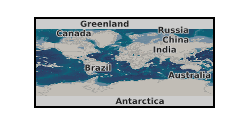The effect of clay content on the dilatancy and frictional properties of fault gouge (NERC Grant NE/L002469/1)
This information details the method of calculating dilatancy from pore volumometry measurements. In the velocity step tests, an initial shear enhanced compaction phase drastically reduces the sample pore volume until the sample yields. After the sample yields, the pore volume continues to decrease but at a lower rate of decrease. The imposed velocity steps cause compaction or dilation of the sample material that is superimposed on this overall compaction trend. Pore pressure is held at a set point in all tests and any volume changes in the control system are assumed to correspond directly to changes in pore volume in the sample. The method here is aimed at producing quantitative, reproducible values for dilatancy from experimental data. The script fits a polynomial function to all the volume data to give the overall trend of the shear enhanced compaction. The data position of the start of the velocity step of interest is entered manually into the function. When dilatancy occurs on a step change in velocity, this is not immediately recorded using volumometry, as the permeability of the sample will produce a transient response as pore fluid pressure equilibrates between the sample and the pore fluid pressure system. To discount time effects, every velocity step was processed with a ‘time_dep’ phase for the first 100µm of displacement after the imposed velocity step change. Using the values for ‘vel_step’ and ‘time_dep’, the volumometry data are split into separate matrices incorporating time and volume preceding and following the velocity step change. A linear regression model fits a polynomial curve to the pore volumometry data and returns the coefficient of determination (R2) for the fit of the model. The shear enhanced compaction phase prior to yield is included in the fit. The code incrementally adds the value entered for ‘step’ to the data in the velocity step of interest. This ‘step’ value is a positive or negative value depending on whether the velocity has increased or decreased, respectively. A new linear regression model is then fitted to the whole dataset and if the R2 value has increased, the code will continue to loop to add the value of ‘step’ to the pore volume data. It concludes when the R2 value reaches a peak and begins to decrease, as the fit is no longer improving. We assume at this point that the effect of the dilatancy due to the velocity step has been removed, and the cumulative sum of the ‘step’ values is equivalent to the dilatancy. As the loop goes one iteration past the optimum R2 value, the code reverts to the previous set of values with the best R2 value. In experiments with multiple velocity step changes, the code needs to retain the previous corrections of the data. The function ‘pf_correct’ is used to correct the velocity steps that have been previously processed. The values for ‘vel_step’, ‘time_dep’ and the returned value of ‘offset’ need to be given in the inputs for ‘pf_correct’.

non geographic dataset
:
http://data.bgs.ac.uk/id/dataHolding/13608050
English
Geoscientific information
GEMET - INSPIRE themes, version 1.0:
BGS Thesaurus of Geosciences:
Dilatancy
NGDC Deposited Data
Compaction
Fault gouge
Free:
Free:
NERC_DDC
creation: 2023-02-17
2019-09-02
-
2023-02-07
University of Liverpool
Isabel Ashman
Jane Herdman Building, 4 Brownlow Street,
Liverpool,
L69 3GP
email:
not available
Role: originator
British Geological Survey
Enquiries
email:
not available
Role: distributor
British Geological Survey
Enquiries
email:
not available
Role: point of contact
Data Quality
Pore volume changes during a test were monitored using the pore pressure control system. The servo-controlled 5000 mm3 pump adjusted the volume of fluid in the system to maintain the pressure from measurements in the sample; a pore pressure increase required pore fluid to be extracted into the pump, whereas a pressure decrease required pore fluid to be added to the sample. By monitoring the displacement of the piston in the pore fluid control pump using a high-resolution linear variable differential transformer (LVDT), the equivalent changes in pore volume in the sample were measured (Figure 2). The maximum volume change that the LVDT could measure with one stroke was 200 mm3 and the measurements were resolvable to 0.01 mm3.
INSPIRE Implementing rules laying down technical arrangements for the interoperability and harmonisation of Geology
Commission Regulation (EU) No 1089/2010 of 23 November 2010 implementing Directive 2007/2/EC of the European Parliament and of the Council as regards interoperability of spatial data sets and services
Constraints
The copyright of materials derived from the British Geological Survey's work is vested in the Natural Environment Research Council [NERC]. No part of this work may be reproduced or transmitted in any form or by any means, or stored in a retrieval system of any nature, without the prior permission of the copyright holder, via the BGS Intellectual Property Rights Manager. Use by customers of information provided by the BGS, is at the customer's own risk. In view of the disparate sources of information at BGS's disposal, including such material donated to BGS, that BGS accepts in good faith as being accurate, the Natural Environment Research Council (NERC) gives no warranty, expressed or implied, as to the quality or accuracy of the information supplied, or to the information's suitability for any use. NERC/BGS accepts no liability whatever in respect of loss, damage, injury or other occurence however caused.
Available under the Open Government Licence subject to the following acknowledgement accompanying the reproduced NERC materials "Contains NERC materials ©NERC [year]"
licenceOGL
Metadata about metadata
f6f198b0-b40e-4a51-e053-0937940a7548
British Geological Survey
Environmental Science Centre,Keyworth,
NOTTINGHAM,
NG12 5GG,
United Kingdom
tel: +44 115 936 3100
email:
enquiries@bgs.ac.uk
Role: point of contact
2024-04-24
